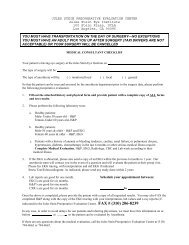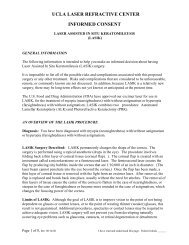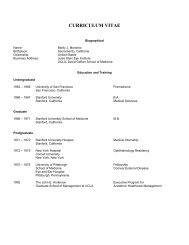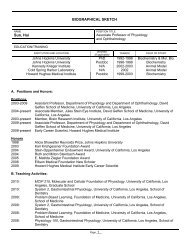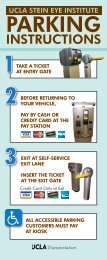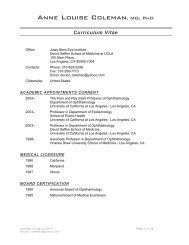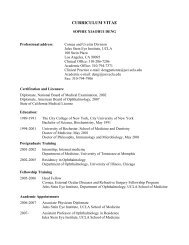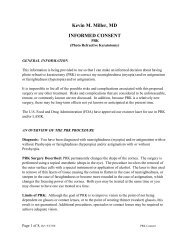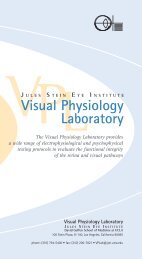View Annual Report - Jules Stein Eye Institute
View Annual Report - Jules Stein Eye Institute
View Annual Report - Jules Stein Eye Institute
Create successful ePaper yourself
Turn your PDF publications into a flip-book with our unique Google optimized e-Paper software.
Robert alan Goldberg, mD<br />
Karen and Frank Dabby Professor of Ophthalmology<br />
Chief of the Orbital and Ophthalmic<br />
Plastic Surgery Division<br />
Director of the UCLA Orbital Disease Center<br />
Co-Director of the UCLA Aesthetic Center<br />
Member of the <strong>Jules</strong> <strong>Stein</strong> <strong>Eye</strong> <strong>Institute</strong><br />
ReseaRch summaRy<br />
Diseases and Therapy<br />
of the <strong>Eye</strong>lid and Orbit<br />
Research into the various surgical approaches to<br />
Graves orbitopathy (thyroid eye disease) has resulted<br />
in new techniques that include less invasive small<br />
incision surgical approaches. In addition, detailed<br />
clinical information gathered from patients with Graves<br />
orbitopathy is being recorded in a shared database as a<br />
way to understand the natural history and response to<br />
treatment of this multifaceted disease, which is a cause<br />
of significant visual loss and discomfort. Multicenter<br />
studies are underway. Dr. Goldberg is also investigating<br />
the underlying causes of thyroid-related orbitopathy.<br />
The goal of this research is to develop better tests to<br />
monitor disease activity, as well as new treatments to<br />
address the basic cause of the disease.<br />
Research into orbital and eyelid anatomy, currently<br />
in progress, is resulting in improved techniques and<br />
approaches to deep orbital disease. Included is the use<br />
of high-resolution magnetic resonance imaging and<br />
high-resolution dynamic ultrasonography to evaluate<br />
motility problems following trauma and orbital surgery,<br />
and three-dimensional analysis of orbital anatomy.<br />
Improved understanding of eyelid and orbital anatomy is<br />
the basis for developing improved surgical techniques.<br />
Instrumentation and devices that allow less invasive<br />
surgical approaches, such as hyaluronic acid gels, are<br />
being developed and studied. In collaboration with the<br />
Department of Engineering, custom materials for orbital<br />
reconstruction are investigated.<br />
Ongoing research related to the reconstruction of the<br />
ocular surface in severe trauma or cicatrizing disease<br />
includes the design and evaluation of improved instrumentation<br />
and surgery techniques. It is hoped that new<br />
treatment approaches can solve problems caused when<br />
damaged eyelids, conjunctiva, and support tissues fail to<br />
provide a supportive environment for the cornea.<br />
40 Faculty | Goldberg<br />
Public Service<br />
Assistant Vice President of Professional Education,<br />
California Academy of Ophthalmology<br />
Fellow and Chair, International Committee, American Society<br />
of Ophthalmic Plastic and Reconstructive Surgeons<br />
Fellowship Program Director, American Academy of<br />
Cosmetic Surgery and American Society of<br />
Ophthalmic Plastic and Reconstructive Surgery<br />
Editorial Board Member, Archives of Ophthalmology,<br />
Ophthalmic Plastic and Reconstructive Surgery,<br />
Aesthetic Surgery Journal, and Archives of Facial Plastic Surgery<br />
Section Editor, American Academy of Ophthalmology,<br />
ONE Network



